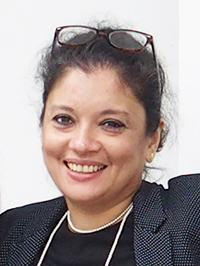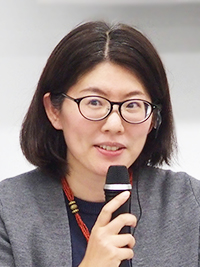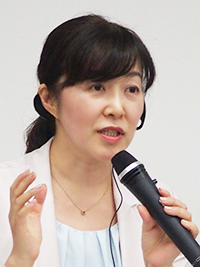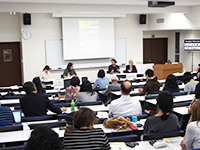IGS hosted an international symposium entitled ‘Women, Religion and Violence in International Perspective’, on October 19, 2016, at Ochanomizu University. This symposium was organised by Dr Erica Baffelli (Specially Appointed Professor, IGS), who invited Dr Atreyee Sen (Associate Professor, Copenhagen University) to give the keynote speech and Dr Mizuho Matsuo (Associate Professor, National Museum of Ethnology) and Dr Mariko Ogawa (PD Fellow, JSPS) as discussants. The programme of the symposium featured a joint research project being conducted by Dr Baffelli and Dr Sen, and they sought interdisciplinary and international feedback on their project.
After an opening remark by Professor Masako Ishii-Kuntz (Director, IGS), Dr Baffelli commenced the symposium with an introduction to the research project, explaining how they came to work on a project on women in radical religious and political movements. Although women actively use weapons and participate in violent actions, the focus of public discourse remains on the victimhood of women. Cases of female suicide bombers are talked of as exceptional. Baffelli and Sen have a shared interest in such misinterpretation and began a joint research project. The project focuses on three aspects, namely, women’s motivation for participating in radical movements, representations and memories. Baffelli also discussed her findings on the role of women leaders in Aum Shinrikyō, the Japanese religious organisation known for their sarin gas attack in Tokyo in 1995.
In her keynote speech, Dr Sen, who studies women’s right wing movements, listed various motivations for and forms of women’s participation in radical movements. She indicated that the existing framework of gender analysis and media representation cannot explain these phenomena. For example, women who join radical religious organisations understand what the organisations do, consider several options and choose to be members after careful thought. Among such women there must be feminists who think they have the ‘right to fight’, as men do. On the other hand, those who regard physical gender differences as important take a supporting part, playing a ‘woman’s role’. This reality does not fit received ideas of women as victims or as peacemakers. Two other important aspects are noted. One is that women’s presence in male-dominated movements always brings about change in the institution. The other is that wartime circumstances shake up existing social norms and patriarchy and empower women. There are particular types of women and female relationships in radical movements. Sen presented a case of women’s solidarity in the Shiv Sena movement. Shiv Sena is a Hindu Nationalist group, and women’s solidarity in the group is not limited to its ideology but is enforced by providing measures of self-defence, such as small knives to carry on public transportation and a smartphone application to prevent rape. Hostility and violence between women exist as well. Women in a radical American Christian fundamentalist group attack and burn abortion clinics and kill and injure immigrant women. They believe that their ideal Christian image of motherhood is the one and only acceptable American one and try to eliminate others. Women in a radical Islamic group in Kashmir, India, attack women who celebrate St. Valentine’s Day, by smearing black ink on those women’s faces and tearing their clothes in public. They reject the entry of foreign culture into their society and are working to cleanse it. Sen concluded her presentation by asking, ‘Is women’s collective violent action “soft feminism”?’ Seeing women’s participation in radical movements through a feminist perspective, you can find certain positive outcomes, such as taking women outside home, empowering them to have weapons and helping increase their self-esteem. In this particular environment, however, women do not openly challenge men or the patriarchy. They manage to produce ‘creative conformity’, which can be defined as a new mode of adaptation, to bring about a transformation of gender norms in society in a soft way.
Dr Matsuo, the first discussant, pointed out that women’s participation in violence has recurred continually in history and in the forms of supporting war and political conflict, but the evaluation of those actions varied depending on when they occurred and whose was the observing perspective. For example, in post-war Japan, at first women were mainly regarded as victims of the war, but after the 1980s, women’s role as supporters or perpetrators of wartime acts came to be discussed. In India, where Matsuo is conducting ethnographic research, independent movements have introduced a gendered rhetoric for the mobilisation of women, which promotes women’s morality and endurance as suitable to nonviolent campaigns. However, current phenomena, which Sen presented, do not match that rhetoric. In cases of dowry murder, women are sometimes arrested for setting fire to a bride’s sari because the dowry the bride brought for the groom’s family is too small. Women also commit honour killings. A senior woman in a family murders a raped daughter because the presence of a rape victim is a dishonour to the family. In such ways, violent incidents occur between women in closed family spheres. This reflects the complex power relationship within a family, including between women, such as between mother and mother-in-law and between daughter and daughter-in-law, and between men and women. The structure of such power relationships might be layered and meshed; it does not fit a simple perpetrator–victim dichotomy.
Dr Ogawa, the next discussant, presented domestic violence (DV) research. DV statistics show that although the male offender–female victim pattern matches 90% of bodily injury and violence, the rate of female offenders goes up to 40% in homicide. In many of these cases of murder, years of abuse by a husband provoke his wife to kill him. This indicates that the perpetrator–victim power relationship is not straightforward. The vast majority of DV victims are still women, but the existence of male victims has started to draw attention. The rate of not seeking help for DV shows a gender difference: 44.9% of women and 75.4% of men. Ogawa pointed out that this difference reflects existing gender bias. Men are likely to be ashamed of speaking about being the subject of their wives’ violent actions; as a result, the reality of male victims is hidden. Even though male victims of DV are becoming visible, the construction of a support system for female victims, the majority, must be prioritized. At the same time, batterers’ education programmes need to be developed. Ogawa added that the difficulty of self-recognition both as batterer and as victim is one of the most difficult aspects in addressing DV.
Q&A session started with Ogawa’s question, ‘Women obtain power by holding weapons and becoming freed from the patriarchy and family, but radical movements and military groups must consist of a patriarchal structure. Don’t women feel that contradiction?’ Sen explained that women participating in radical movements do not use the concept of ‘patriarchy’ to think about their condition, and this suggests the limits of the academic framework for gender in understanding the reality of these women. This indicates that the project Baffelli and Sen are conducting will challenge the analyses of conventional researchers, which depend on existing theoretical frameworks. Many questions from the audience followed, and each question led to a lively discussion between the speakers and the audience. This symposium provided an occasion to introduce the outline of Baffelli and Sen’s project, and it is expected that another symposium on its outcome will be held.
Kumi Yoshihara (Project Research Fellow, IGS)

Erica Baffelli

Atreyee Sen

Mizuho Matsuo

Mariko Ogawa


